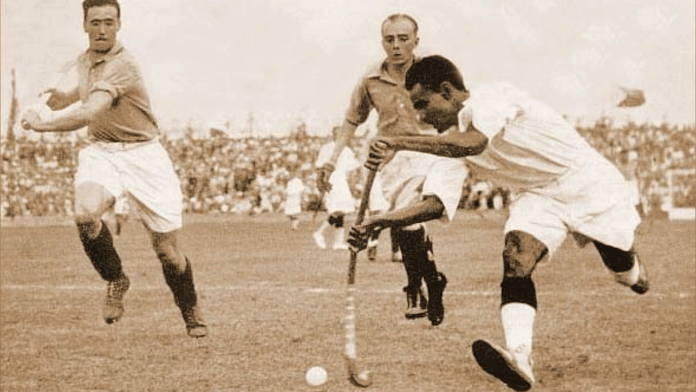Indian field hockey player and Olympic gold medallist Dhyan Chand was famous for outmanoeuvring his rivals with unparalleled finesse. But very few know that the sports wizard dodged death twice during his extraordinary playing career.
His first miraculous escape came a year before the 1936 Berlin Olympics, where British India defeated Nazi Germany 8-1 to win its third gold medal.
After an impressive double-gold streak at the 1928 Amsterdam Olympics and the 1932 Los Angeles Olympics, Dhyan Chand narrowly escaped the catastrophic 1935 earthquake in Quetta, Balochistan. “If he had remained with his regiment at Quetta instead of joining the touring team to New Zealand, who knows what might have happened to him!” wrote JC Maitra, sports editor of The Bombay Chronicle, in his popular no-holds-barred column, Sports Jottings from Here and There, published on 9 June 1935.
The 7.7 magnitude earthquake hit Quetta on 30 May 1935 with shock waves felt in Amritsar, Shimla, Sultanpur, and Agra. It reportedly killed between 30,000 and 60,000 people, almost reducing Quetta, the British Indian Army’s headquarters in Balochistan, to rubble.
Cricketer rumoured dead, hockey hero safe
Dhyan Chand was safe and sound thousands of kilometres away from the epicentre, but one of his contemporaries from the Indian cricket team became a victim of bizarre death rumours.
This was Mohammad Nisar, the Indian pacer who bowled the first delivery for India against England at Lord’s on 25 June 1932. The Indian cricket fraternity and its fans were shocked when a news wire declared Nisar dead in the Quetta earthquake.
A report published in The Hindu on 5 June 1935 claimed: “Mahomed Nisar, the well-known Indian fast bowler and Test cricketer, is dead. Nisar was at Quetta at the time of the earthquake and perished along with tens of thousands of other people.”
Incidentally, Nisar, then 25, read his own obituary and immediately called “the Associated Press office in Lahore [and] explained that he had not been anywhere near Quetta at all.” The “dead man” then dramatically entered the agency office to bust the fake news [The Hindu, 8 June 1935].
As per The Bombay Chronicle, when the tragic news of the quake reached Dhyan Chand and his team in New Zealand, they made a unique plan.
Besieged by autograph hunters since their arrival in Wellington and fresh from their 12-0 victory over South Canterbury, the star-studded Indian hockey team decided to charge sixpence for each autograph for the Indian Earthquake Relief Fund. Dhyan Chand was instrumental to the plan as his star value generated the lion’s share of donations.
Also read:
Missed Japanese massacre by a whisker
Interestingly, the triple Olympic gold medal-winning Indian hockey icon had another brush with death a few years later when he was posted in Hong Kong with the 2nd Battalion of the 14th Punjab Regiment in 1941.
Dhyan Chand, who had briefly served in China, recounted the experience in his autobiography, Goal!. “I had a lucky escape once. My regiment was stationed in China in 1942, and fortunately for me, I was sent back to Ferozepur just six months before my entire regiment was captured by the Japanese.” However, Hong Kong-based military historian Philip Cracknell issued a clarification to this author: “I don’t think [the] 2/14 Punjab Regiment was ever in Mainland China; I think they were just stationed in HK, and that was in the year of 1941, not 1942. But I must say Dhyan Chand was fortunate to be re-posted before the battle commenced in December 1941.”
According to Tony Banham, founder of the Hong Kong War Diary project, which studies and documents the 1941 defence of Hong Kong, and author of Not the Slightest Chance: The Defence of Hong Kong, 1941, Dhyan Chand’s 2/14 Punjab regiment was “In Hong Kong the Punjabis were responsible for coastal defences from Causeway Bay to Belcher’s point. Battalion HQ was located in McDonnell road.” In addition, Banham wrote, the garrison also provided protection for “Government House and Fortress Headquarters” in the former British colony.
However, shortly after their Kamikaze pilots attacked the US’ Pearl Harbour base, Japanese troops launched their first assault on Hong Kong on 8 December 1941 – the beginning of Hong Kong’s fall during World War II. According to Banham, the 2/14 Punjab suffered quite a blow as 55 of its soldiers were killed in action or died from wounds, 69 went missing, and 161 were wounded. Dhyan Chand could have been as unfortunate as his regiment members if destiny hadn’t intervened just in time and saved his life for the second time in six years. No wonder the hockey magician knew the Houdini-like disappearing act from the death scene.
Suvam Pal is an independent media professional, author & documentary filmmaker. He tweets @suvvz. Views are personal.
(Edited by Zoya Bhatti)






